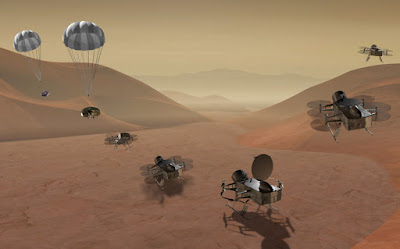 |
| Dragonfly is a dual-quadcopter lander that would take advantage of the environment on Titan to fly to multiple locations, some hundreds of miles apart. (Credit: NASA) |
Topics: NASA, Space Exploration, Spaceflight
NASA accepted twelve mission proposals comprising six themes: comet surface sample return, lunar south pole-Aitken Basin sample return, ocean worlds (e.g., Saturn’s moons Titan and Enceladus), Saturn probe, Trojan asteroid tour and rendezvous and Venus in situ explorer. They whittled these proposals down to two, through an extensive peer review process. These missions will proceed into Phase A development, after which, one will be selected for flight in July 2019, to launch by 2025.
The two missions selected, the Comet Astrobiology Exploration Sample Return (CAESAR) and Dragonfly, would see NASA return to old stomping grounds, but with new technology.
Comets, which are essentially amalgamations of some of the oldest materials in the solar system, are among the most poorly understood, pristine records of the solar system’s history. CAESAR, led by principal investigator Steve Squyres, proposes a return to 67P/Churyumov-Gerasimenko, a comet previously explored by the European Space Agency’s Rosetta spacecraft.
“By going to that comet, there’s an enormous amount of risk reduction that takes place,” says Squyres. “We’re going to an object we’ve already got good maps of.”
He continued:
“What distinguishes them from every other primitive body out there is what we call their volatile component: ices, the volatile organic compounds that just aren’t present in any other planetary body.”
The CAESAR mission would extract separate volatile and nonvolatile samples from the comet’s icy nucleus, and return them to analysis in November of 2038.
Dragonfly, the second finalist, would set sail to Titan, one of Saturn’s moons.
“Titan is a unique ocean world,” principal investigator Elizabeth Turtle said.
Indeed, Titan is rich with complex hydrocarbons and water beneath its frozen shell, richly detailed by Cassini. The probe itself, a rotocraft, would spend most of its time collecting samples on the ground, studying Titan’s habitability by determining how far prebiotic chemistry has progressed. Turtle said it would be able to fly hundreds of kilometers at a time to make measurements in different geologic settings.
NASA’s New Frontiersmen, Ian Graber-Stiehl, Discovery Magazine
Comments